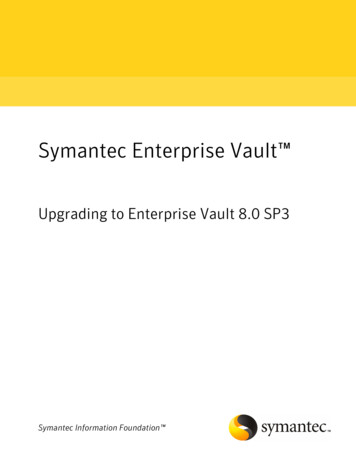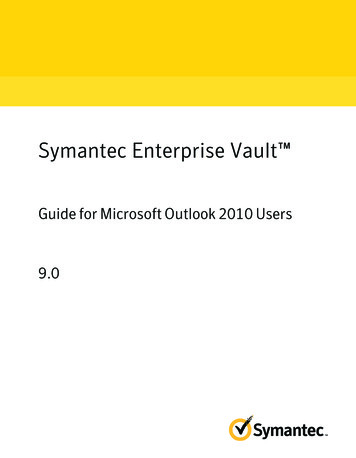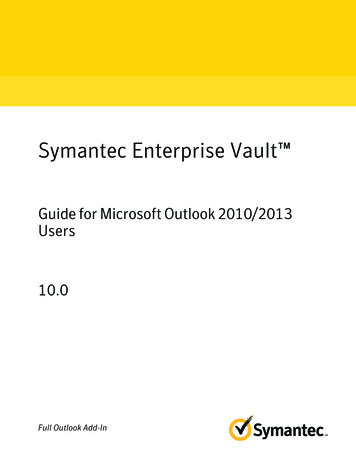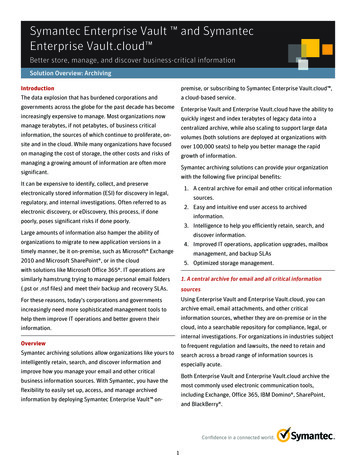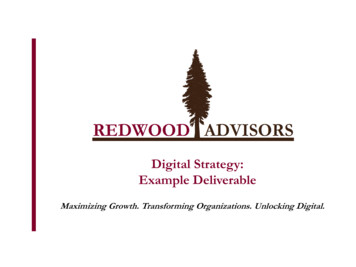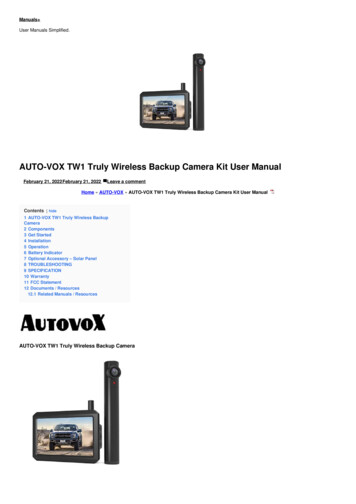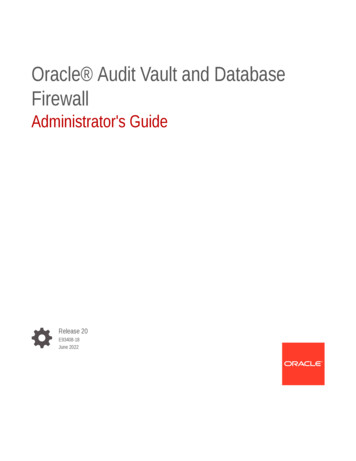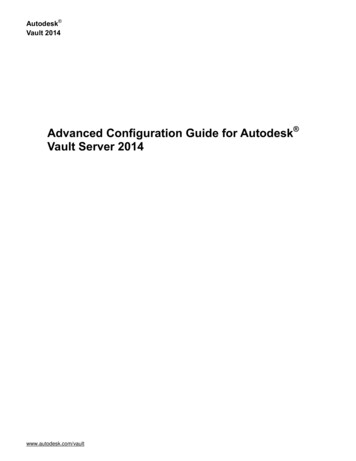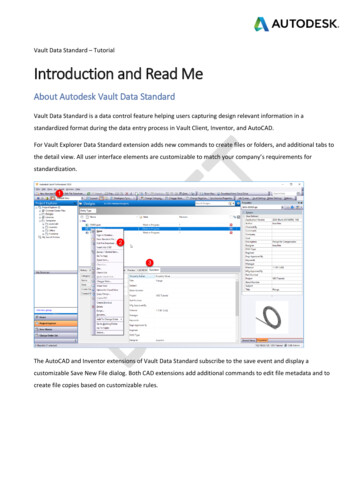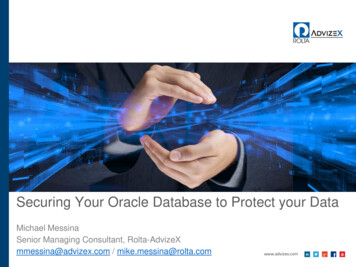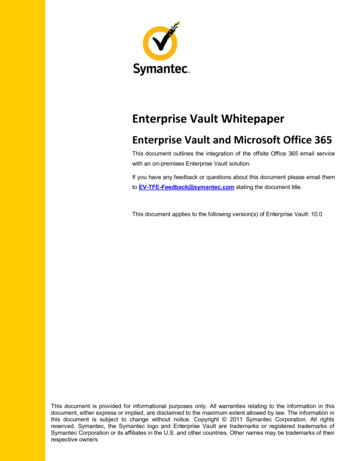
Transcription
Enterprise Vault WhitepaperEnterprise Vault and Microsoft Office 365This document outlines the integration of the offsite Office 365 email servicewith an on-premises Enterprise Vault solution.If you have any feedback or questions about this document please email themto EV-TFE-Feedback@symantec.com stating the document title.This document applies to the following version(s) of Enterprise Vault: 10.0This document is provided for informational purposes only. All warranties relating to the information in thisdocument, either express or implied, are disclaimed to the maximum extent allowed by law. The information inthis document is subject to change without notice. Copyright 2011 Symantec Corporation. All rightsreserved. Symantec, the Symantec logo and Enterprise Vault are trademarks or registered trademarks ofSymantec Corporation or its affiliates in the U.S. and other countries. Other names may be trademarks of theirrespective owners
Enterprise Vault Whitepaper - Enterprise Vault and Microsoft Office 365Document ControlContributorsWhoContributionChristopher Moreau,AuthorSenior Product ManagerAndy Joyce,EditorDirector, Technical Field EnablementRevision HistoryVersionDateChanges1.0April 2010Original version for Microsoft BPOS2.0August 2011Updated for Office 365 and Enterprise Vault 10Related DocumentsVersionDateTitlei
Enterprise Vault Whitepaper - Enterprise Vault and Microsoft Office 365Table of ContentsOverview1Target Audience1Why use Enterprise Vault with Office 365?1Office 365 Journaling3PST Migration Limitations4Mailbox Archiving4Summary5AppendicesAppendix A - Journal Task Configuration SettingsAppendix B - PST Configuration Settingsii
Enterprise Vault Whitepaper - Enterprise Vault and Microsoft Office 365OverviewMicrosoft Office 365 is a set of Microsoft hosted messaging and collaboration services, which includesExchange Online (v 2010), SharePoint Online, Lync Online and Office Web Applications. Customers maywish to deploy the Microsoft Office 365 solution for their email services, thus migrating Exchange 2010offsite, whether to reduce costs associated with running an email environment or to free resources withinthe corporation to perform other tasks. This document outlines the integration of the offsite Office 365email service with an on-premises Enterprise Vault solution.For more information on the MS Office 365 solution please e-software.aspx#fbid nh5laZUP0QQTarget AudienceThis document is intended for Systems Engineers, Administrators as well as individuals who leverage theEnterprise Vault 10.0 application to Journal messages for use in eDiscovery and Compliance purposes.Why use Enterprise Vault with Office 365?The current Office 365 offering provides an archiving feature known as Exchange Hosted Archiving. Thisoffering provides basic archiving features allowing the user to maintain an ongoing copy of historical emailfor a period of time defined on a per company basis. While this feature set may service the customer withbasic needs for archiving, there are instances where this offering will not cover the breadth of functionalityrequired by more demanding use cases related to compliance, eDiscovery or corporate governance.Table 1 shows which interactions with Microsoft Office 365 are supported by Enterprise Vault 10.0.Enterprise Vault FeatureExchange Server JournalingSupportYPST MigrationP (Note 1)Exchange Mailbox ArchivingN (Note 2)Exchange Public Folder Archiving NTable 1 - Supported FeaturesNotes:1.2.PST Migration will function as outlined later in this documentThe current integration with Office 365 requires an intermediary Exchange Server to receive Journal data. There is nodirect access to the cloud based Exchange server and therefore mailbox archiving is not supported at this timePage 1
Enterprise Vault Whitepaper - Enterprise Vault and Microsoft Office 365The following are examples of requirements that can be provided by leveraging Enterprise Vault andOffice 365 Journaling: SEC 17a-4 compliant storage – Within SEC 17A-4 there is stated the need to archive multiplecopies of electronic communications for broker dealer licensed individuals on non-mutable media.Enterprise Vault supports the use of WORM media to perform this operation while many hostedsolutions do not provide such functionality. Retention Policy Management – Enterprise Vault provides the ability to archive data and assignretention leveraging a policy scheme that can be configured to meet the needs of the company bythe user/group or content of the data for true information management. Hosted offerings oftendeliver only a very high-level company-wide retention setting, which can result in over-retention orunder-retention scenarios. Repository of Record for Multiple Data Types – An on-premises Enterprise Vault solution canalso be used to archive, store, manage and discover other data types from on-premises fileshares, SharePoint, instant messaging servers, databases as well as other information to beused for business purposes and in the eDiscovery process. eDiscovery Cost Reduction and Workflow – The eDiscovery process requires the collection ofmore than just email and IM received from a journal stream. Often there is a need to collect datafrom sources such as file shares, SharePoint sites, databases, SAP and other local resourcessuch as desktops and laptops. Enterprise Vault provides the ability to collect, preserve andproduce data natively and through advanced tool sets such as Symantec Discovery Collector andthe Guidance Encase Ingest Connector to perform legal hold, review and production usingDiscovery Accelerator in-house. Companies continue to in-source this aspect of the eDiscoveryprocess to reduce costs and risk. In a recent Fulbright and Jaworski survey 50-60% ofrespondents reported taking the preservation and collection process in-house while 62% reportedperforming internal investigations with internal resources. Supervisory Review – The compliance review process required by Financial Services to complywith FINRA 3010 & 3011 requires the review of data, as well as auditing of the process using atool set which allows a hierarchy to perform proper review, escalation and auditing and tracking ofthe process. By leveraging the Compliance Accelerator the customer now has access to apowerful tool to meet these requirements.Page 2
Enterprise Vault Whitepaper - Enterprise Vault and Microsoft Office 365Office 365 JournalingThe Office 365 Journaling feature provides a company the capability to have a Journal data stream sentto an on-premises archiving solution via use of the Exchange Journaling function. A company wishing toleverage this method is required to configure the journaling feed through Microsoft Office 365 support orconfigure the Journaling target via the Office 365 administration portal. The company must provide alocal address to receive the data.There are infrastructure and security configuration settings associated with the Microsoft HostedExchange solution, which result in some requirements in configuring Enterprise Vault for JournalArchiving.MS Exchange envelope journal emails needs to be delivered via SMTP to an “external” journal mailbox.Thus there is a requirement for a receiving SMTP server, at this point Enterprise Vault supports extractingsuch data via MAPI from Exchange Server.Customer DomainOffice 365 (Microsoft Online) Domain(One Way Trust)ArchivingEnterprise VaultExchange Journaling via SMTPOn Premise End UsersOffice 365 ExchangeExchange Server(End User Mailboxes)Figure 1 - MS Exchange envelope journal email is delivered to “external” journal mailboxes,hosted in an on-premises MS Exchange server from which Enterprise Vault will extract the datausing currently supported methods.Symantec Enterprise Vault does not provide a Message Transfer Agent at this time; therefore anintermediary MS Exchange server located on the customer premise is required to receive the datatransfer from the Office 365 environment. The Enterprise Vault server then extracts the data from theJournal mailbox via an Enterprise Vault Journaling Task.All envelope information is available forindexing up to and including all recipient information (including BCC data), any information that wascontained in the distribution lists from the Microsoft environment as well as all content of the message.Page 3
Enterprise Vault Whitepaper - Enterprise Vault and Microsoft Office 365There are a few minor configuration settings required to process the data that are outlined in theAppendix of this document.Note: As of Exchange 2007 the MS Exchange Journaling feature may create duplicate messages during the Journalingprocess depending on the number of recipients in the message. This occurs if say there are more than 1000 members in aparticular distribution list or the address list contains addresses of different types, such as local mailboxes, distributionlists and external SMTP addresses. Enterprise Vault has a built in process in the Exchange Journaling task which is used toreconstitute multiple reports into single message thus only creating one entry in the archive for the particular messageand thus returning only the single search result in the Discovery process.PST Migration LimitationsThe customer may wish to use the PST migration process of Enterprise Vault to ingest legacy PST datafor use in the legal discovery process. The PST migration process requires connectivity to the mailbox inorder to function properly and populate the proper sender information in the message when beingingested into the Enterprise Vault archive.The PST migration builds the recipient XML looking for an SMTP address from the following properties (inthis order):PR DEFAULT SMTP ADDRESSPR EMAIL ADDRESSPR OrgEmailAddrIf these do not resolve to an SMTP address Enterprise Vault will create a MAPI session to open theGlobal Address Book to perform a look up on the address. This requires that there is at least oneExchange server target enabled in the EV install otherwise the process will fail.The sender is more likely to be an issue as this is much more likely to not be an SMTP address (i.e. anyinternal mail dragged to a PST will have an EX address type).The PST Migration process as of Enterprise Vault 8.0 Service Pack 4 has been extended to allow theability to handle the scenario where the Exchange address cannot be resolved via the local GlobalAddress list. This can be configured using the steps outlined in the Appendix of this document.Mailbox ArchivingThe current access methods provided by the Office 365 solution do not allow Enterprise Vault to accessto the hosted Exchange server environment therefore mailbox archiving is not possible at this time. In theevent a customer is migrating to the Microsoft Office 365 solution for hosted email from an on-premisesExchange solution where Enterprise Vault has been used to archive email from mailboxes, it isrecommended to extract all mailbox archive data from the archive to PST for import to the Office 365Page 4
Enterprise Vault Whitepaper - Enterprise Vault and Microsoft Office 365environment. All Journal data residing in Journaling archives can remain in the event the customerwishes to continue journaling from the Office 365 environment.Following are some additional considerations when migrating from an on-premises Exchange solutionwith Enterprise Vault, to an Office 365 solution with or at a site where Enterprise Vault is not currentlyinstalled: Virtual Vault - The current version of Virtual Vault requires the presence of the mailbox andtherefore will not function correctly if the mailbox is deleted from the domain after the user hasbeen migrated to the Office 365 environment. Shortcuts - The shortcut provides reference to an internal Enterprise Vault server that is mostoften located within the user domain/forest. Any shortcut that has been migrated to the remoteOffice 365 solution will therefore attempt to connect to the internal domain, which will result in afailure to retrieve the item(s) from the archive.SummaryIn conclusion, the White Paper has focused on how to configure Enterprise Vault 10.0 to archive aJournal archiving stream from an on premises Exchange server receiving Journaled data from a hostedMicrosoft Office 365 solution for use in eDiscovery and Compliance archiving. While this document is nota replacement for formal training, it will enable you and your organization to get started and will serve asa reference.Page 5
Appendix A - Journal Task Configuration Settings1. Internal/External Recipient Markings - Since the Exchange Server is no longer local to the userdomain, there is no indication that the message data is from an internal or external user (i.e. thereis no correlation that Joe User login Joe.User@company.msonline.com).This can be overcomeby inserting a registry entry on the Enterprise Vault server to identify the BPOS email domain asbeing “internal” email traffic. This is useful for use in configuring searches and review in theAccelerator applications as well as for use in classification rules.a. To add internal domains using the InternalSMTPDomains registry value perform thefollowing steps on all Enterprise Vault servers in the environment:i. Open the Registry Editor.ii. Create a string value that is called InternalSMTPDomains under the followingkey:HKEY LOCAL MACHINE\Software\KVS\Enterprise Vault\Agentsiii. Give InternalSMTPDomains a value that specifies the required domains as asemicolon-delimited string.For example, you would set the value to the following to treat addresses asinternal:eginc.com;eg.parentcorp.comb. The Journal Connector must be installed on the Enterprise Vault server for proper use ofthis functionality.2. The use of the Journal stream is to capture data for use in legal discovery and compliance use cases.Since Distribution List information is contained in the message envelope, the DL expansion functionwill not be required on the Enterprise Vault server and thus can be disabled. To disable distributionlist expansion:a.Open the Enterprise Vault Administration Console.b. Expand the contents of the left pane until the journaling policies are visible.c.Right-click the required policy, and then click Properties. For example:d. Click the Advanced tab, and then click the Expand distribution lists setting.e.Click Modify, and then change the value to Off.f.Click OK in each dialog box to save the changes that you have made.g. Restart the Journaling task to put the change into effect.
Appendix B - PST Configuration SettingsA registry value can be enabled which results in address resolution lookups to be bypassed. No attemptwill be made to connect to an Exchange Server (even if one exists in the Enterprise Vault directorydatabase) and the default will be to use the attribute PR EMAIL ADDRESS for recipients andPR SENDER EMAIL ADDRESS and PR SENT REPRESENTING EMAIL ADDRESS for senderinformation.1. Open the registry editor2. Locate the following registry entry:HKEY LOCAL MACHINE\Software\KVS\Enterprise Vault\Storage3. Add the following entry[REG DWORD] BypassAddressLookups0 OFF (Default – lookups still attempted)1 ON (Bypass lookups and index the attributes per the MAPI message)The registry value must be applied to all Enterprise Vault servers running a Storage Service, PSTMigrator task or other PST migrations. Any change to the setting will require the appropriate services,tasks and migrators to be restarted.
About Symantec:Symantec is a global leader inprovidingstorage,securityandsystems management solutions tohelp consumers and n world.Our software and services protectagainst more risks at more points,more completely and reverorstored.For specific country offices andSymantec Corporationcontact numbers, please visit ourWorld HeadquartersWeb site: www.symantec.com350 Ellis StreetMountain View, CA 94043 USA 1 (650) 527 8000 1 (800) 721 3934Copyright 2011 SymantecCorporation. All rights reserved.Symantec and the Symantec logoare trademarks or registeredtrademarks of SymantecCorporation or its affiliates in theU.S. and other countries. Othernames may be trademarks of theirrespective owners.
The Office 365 Journaling feature provides a company the capability to have a Journal data stream sent to an on-premises archiving solution via use of the Exchange Journaling function. A company wishing to leverage this method is required to configure the journaling feed through Microsoft Office 365 support or
